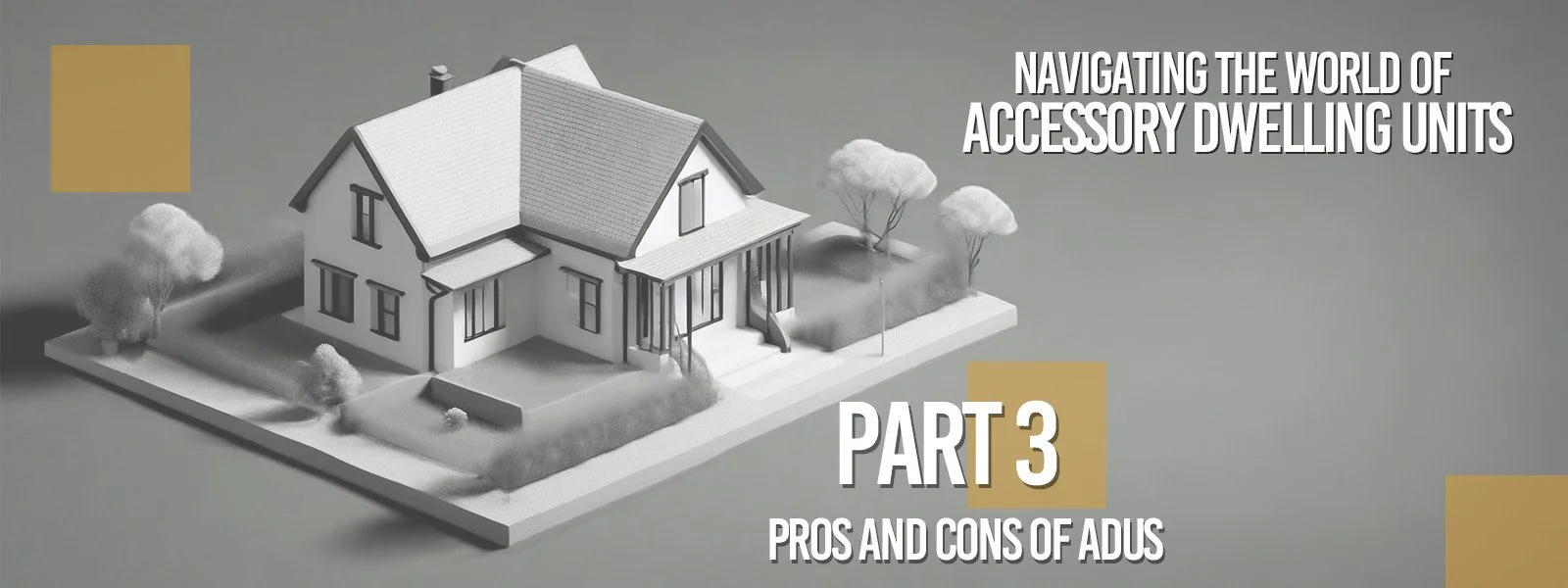Accessory Dwelling Units: Comprehensive Guide - Part 3
Estimated Reading Time 5 mins.
Pros and Cons of Accessory Dwelling Units, Benefits and Realities.
Let’s continue exploring the realm of residential innovation as we unravel the dual tapestry of Accessory Dwelling Units (ADUs), promising not just additional space but a reimagined way of living. In this exploration, we unveil the top 5 advantages that transform your property into a dynamic asset, offering financial gains, enhanced living options, and sustainable solutions. But the journey isn't without its challenges. Brace yourselves as we also delve into the top 5 disadvantages, shedding light on the complexities that come with incorporating ADUs. From the promise of multigenerational harmony to the potential strain on resources, we navigate the intricate landscape of ADUs to help you make informed decisions about the future of your home. Welcome to a space where possibilities and challenges converge – welcome to the discourse on the Pros and Cons of Accessory Dwelling Units, let’s get started!
Top 5 Advantages of Accessory Dwelling Units
Embarking on the journey of Accessory Dwelling Units (ADUs) opens doors to a myriad of advantages that redefine the way we envision living spaces. Let's start by unraveling the top 5 benefits that make ADUs a game-changer in the realm of housing:
Elevated Property Value:
ADUs aren't just additional structures; they're investments in your property's future. By adding a well-designed and functional ADU, you're not only expanding your living space but significantly increasing the overall value of your property. It's a savvy move that pays dividends in both lifestyle enhancement and financial gain.
Rental Income Potential:
Transform your property into a source of passive income by renting out the ADU. Whether it's a cozy studio or a fully-equipped living space, the rental income generated can provide financial flexibility, helping to offset mortgage costs or fund other ventures. ADUs offer homeowners the opportunity to turn their property into a dual-purpose asset.
Multigenerational Living Solutions:
ADUs address the evolving dynamics of modern families. From elderly parents seeking independence to adult children moving back home, the flexibility of ADUs allows for the creation of separate yet connected living spaces. It's a thoughtful solution that fosters multigenerational living without compromising privacy or comfort.
Quick Construction Time and Efficiency:
Unlike traditional home expansions, ADUs boast shorter construction timelines. The efficiency in design and construction not only saves time but also minimizes disruption to your daily life. Whether you're looking for a speedy solution or a hassle-free construction process, ADUs deliver with a blend of practicality and efficiency.
Sustainable and Adaptive Living:
ADUs contribute to a more sustainable living ethos. With a smaller environmental footprint, efficient use of resources, and the potential for energy-efficient design, ADUs align with a modern commitment to environmental responsibility. Additionally, the adaptability of ADUs allows homeowners to repurpose their spaces over time, catering to changing needs without the need for extensive renovations.
“In the dynamic landscape of residential living, ADUs emerge as catalysts for change, offering homeowners a versatile toolkit to enhance property value, foster multigenerational connections, generate income, and embrace sustainable living. It’s not just about additional space; it’s about transforming your home into a dynamic, adaptable, and truly enriching living experience. ”
Top 5 Disadvantages of Accessory Dwelling Units
While Accessory Dwelling Units (ADUs) bring a host of benefits, it's important to consider the potential challenges associated with their implementation. Let's dive into the top 5 disadvantages, providing a balanced perspective on the complexities of incorporating ADUs into your property:
Cost Considerations:
One of the primary drawbacks of ADUs can be the associated costs. Building a new structure or converting existing space can incur expenses, including permits, construction, and utility connections. While they can be a savvy investment, the initial financial outlay can be a barrier for some homeowners.
Regulatory Hurdles:
Navigating local regulations and zoning ordinances can be a complex process. Some areas have strict rules governing the construction and use of ADUs, including size restrictions, setback requirements, and design limitations. The regulatory landscape can pose challenges, requiring careful navigation to ensure compliance.
Potential Strain on Resources:
Introducing an ADU to your property may strain existing resources, especially in terms of utilities and parking. Increased demand for water, electricity, and parking spaces can create logistical challenges, potentially impacting the comfort and convenience of both the main residence and the ADU.
Privacy Concerns:
While ADUs offer the potential for multigenerational living or rental income, the proximity of these additional living spaces can raise privacy concerns. Balancing the need for independence with the realities of shared space requires thoughtful design and communication, as privacy issues may arise for both the main home and ADU occupants.
Potential for Overbuilding:
In some cases, the addition of an ADU may lead to overbuilding, where the property becomes crowded or the new structure overwhelms the existing landscape. Striking a harmonious balance between the main residence and the ADU is crucial to ensure both structures coexist seamlessly.
In the pursuit of innovative housing solutions, acknowledging the potential disadvantages of ADUs is essential. While these challenges are not insurmountable, they underscore the importance of careful planning, thorough research, and open communication with local authorities and stakeholders. By navigating these complexities thoughtfully, homeowners can make informed decisions that align with their goals and aspirations.
Coming up… 01/01/2024 “Regulatory Conssiderations” stay tuned!


